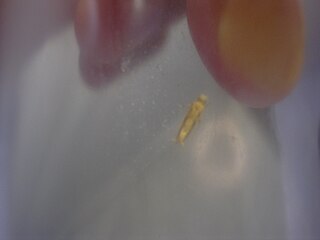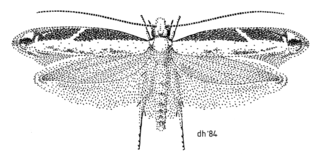
Erechthias is a genus of the fungus moth family, Tineidae. Therein, it belongs to the subfamily Erechthiinae, of which it is the type genus. The exact circumscription of this genus is still disputed, but it may encompass more than 150 species.

Erechthias minuscula, the erechthias clothes moth, is a moth of the family Tineidae. It was first described by Lord Walsingham in 1897. It is widespread and has been recorded from Africa, Sri Lanka, Java, Australia, the Caroline Islands, Fiji, Samoa, the Marquesas, the West Indies, Hawaii and Florida.

Erechthias chionodira is a species of moth in the family Tineidae. It was described by Edward Meyrick in 1880 using two specimens obtained in Auckland on a shady bank amongst forest in January. This species is endemic to New Zealand.
Erechthias dracaenura is a moth of the family Tineidae. It is endemic to São Tomé Island, an island off the western equatorial coast of Central Africa. The species was described by Edward Meyrick in 1934.
Erechthias lychnopa is a species of moth in the family Tineidae. This species is endemic to New Zealand. It is classified as "Data Deficient" by the Department of Conservation.
Erechthias acrodina is a species of moth in the family Tineidae. It was described by Edward Meyrick in 1912 using a specimen collected by George Vernon Hudson in Wellington. This species is endemic to New Zealand.

Erechthias charadrota is a species of moth in the family Tineidae. It was described by Edward Meyrick in 1880 using three specimens caught in dry forest-scrub near Wellington and Port Lyttelton during the month of January. This species is endemic to New Zealand.

Erechthias chasmatias is a species of moth in the family Tineidae. It was described by Edward Meyrick in 1880 using two male specimens taken in forest in Wellington in January. This species is endemic to New Zealand. It has been found in the Wellington Botanic Garden.
Erechthias crypsimima is a species of moth in the family Tineidae. It was described by Edward Meyrick in 1920 using a specimen collected by George Vernon Hudson in Wellington in February. This species is endemic to New Zealand. Hudson noted that he collected the type specimen of this species from the black trunk of a beech tree.
Erechthias exospila is a species of moth in the family Tineidae. It was described by Edward Meyrick in 1901 using a specimen he collected in Whangarei in December. This species is endemic to New Zealand.
Erechthias externella is a species of moth in the family Tineidae. It was described by Francis Walker in 1864. This species is endemic to New Zealand.
Erechthias fulguritella is a species of moth in the family Tineidae. It was described by Francis Walker in 1863. This species is endemic to New Zealand.
Erechthias hemiclistra is a species of moth in the family Tineidae. It was described by Edward Meyrick in 1911. This species is endemic to New Zealand. Entomologist George Hudson reared this moth from caterpillars and cocoons in the flower stems of Chionochloa conspicua at Makara. The adults emerged in November and February. The food of the larvae of this species is apparently dead woody fibre.
Erechthias indicans is a species of moth in the family Tineidae.It was described by Edward Meyrick in 1923. This species is endemic to New Zealand. The holotype specimen of this species was collected by George Vernon Hudson in Karori, Wellington.
Erechthias macrozyga is a species of moth in the family Tineidae. It was described by Edward Meyrick in 1916. This species is endemic to New Zealand. The holotype specimen of this species was collected at Tisbury, Invercargill by Alfred Philpott.
Erechthias stilbella is a species of moth in the family Tineidae. It was described by Edward Doubleday in 1843. This species is endemic to New Zealand.
Erechthias terminella is a species of moth in the family Tineidae. It was described by Francis Walker in 1863. This species is endemic to New Zealand.
Monopis typhlopa is a species of moth in the family Tineidae. It was described by Edward Meyrick in 1925. This species is endemic to New Zealand.

Asaphodes chlorocapna is a species of moth in the family Geometridae. This species is endemic to New Zealand and can only be found in the Chatham Islands. The larvae of this species consume the leaves of Muehlenbeckia plants. Adults are on the wing in January. This species is classified as "At Risk, Relict'" by the Department of Conservation.
Erechthias transfumata is a moth of the family Tineidae first described by Edward Meyrick in 1915. It is found in Sri Lanka.







